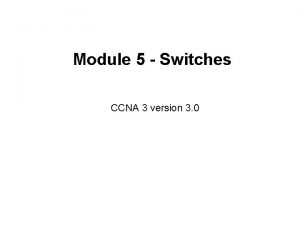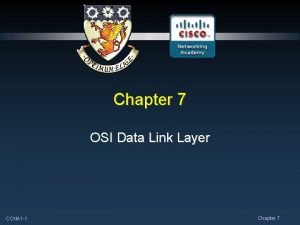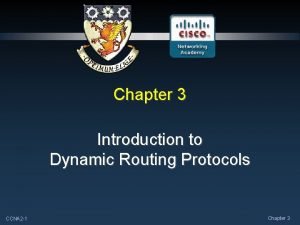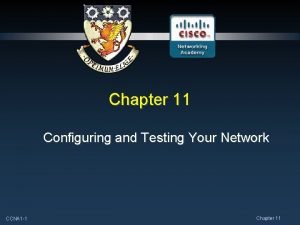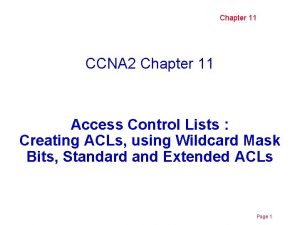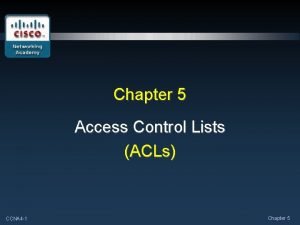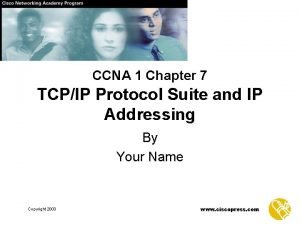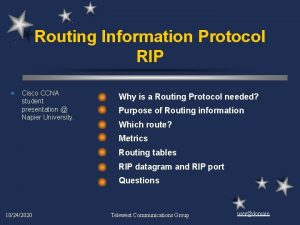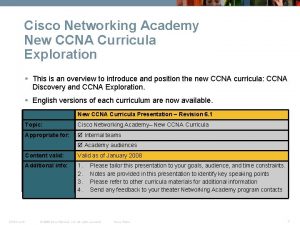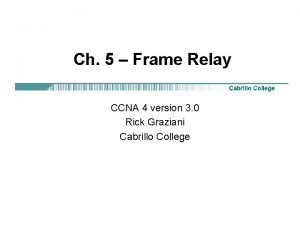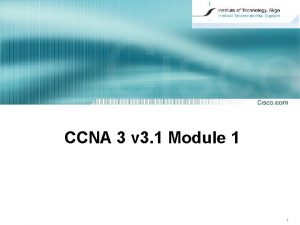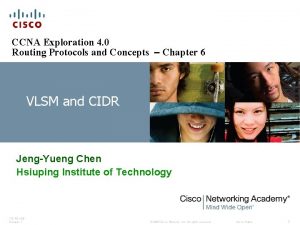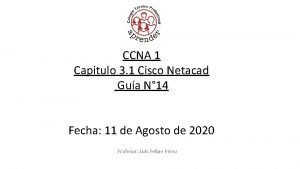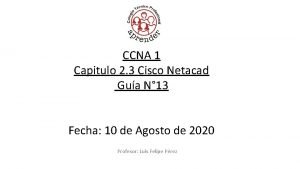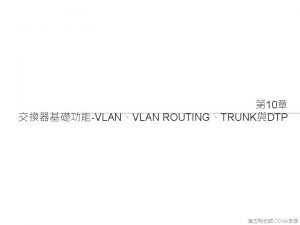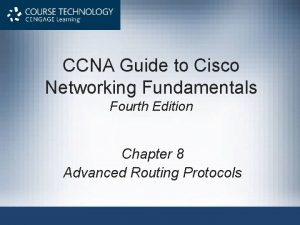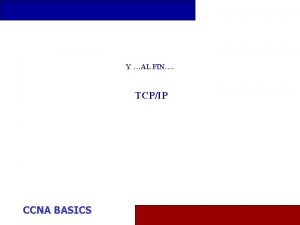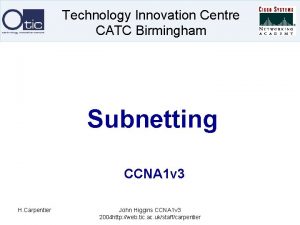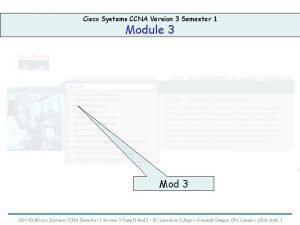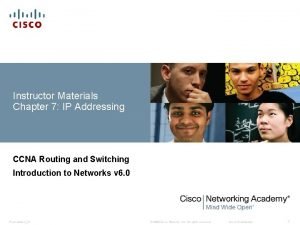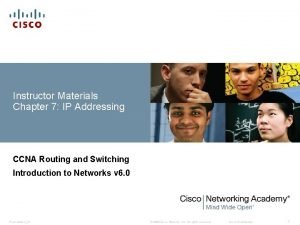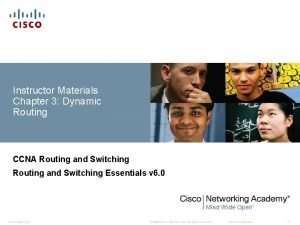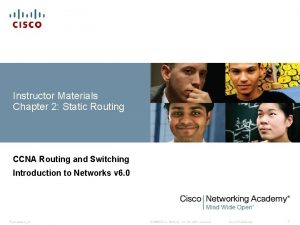Instructor Materials Chapter 7 IP Addressing CCNA Routing

















































- Slides: 49

Instructor Materials Chapter 7: IP Addressing CCNA Routing and Switching Introduction to Networks v 6. 0 Presentation_ID © 2008 Cisco Systems, Inc. All rights reserved. Cisco Confidential 1

Chapter 7: IP Addressing CCNA Routing and Switching Introduction to Networks v 6. 0 Presentation_ID © 2008 Cisco Systems, Inc. All rights reserved. Cisco Confidential 3

Chapter 7 - Sections & Objectives § 7. 1 IPv 4 Network Addresses • Convert between binary and decimal numbering systems. • Describe the structure of an IPv 4 address including the network portion, the host portion, and the subnet mask. • Compare the characteristics and uses of the unicast, broadcast, and multicast IPv 4 addresses. • Explain public, private, and reserved IPv 4 addresses. § 7. 2 IPv 6 Network Addresses • • • Explain the need for IPv 6 addressing. Describe the representation of an IPv 6 address. Describe types of IPv 6 network addresses. Configure global unicast addresses. Describe multicast addresses. § 7. 3 Connectivity Verification • Explain how ICMP is used to test network connectivity. • Use ping and traceroute utilities to test network connectivity. Presentation_ID © 2008 Cisco Systems, Inc. All rights reserved. Cisco Confidential 4

7. 1 IPv 4 Network Addresses Presentation_ID © 2008 Cisco Systems, Inc. All rights reserved. Cisco Confidential 5

IPv 4 Network Addresses Binary and Decimal Conversion § Binary Numbers vs Decimal Numbers • Binary is a numbering system that consists of the numbers 0 and 1 called bits. In contrast, the decimal numbering system consists of 10 digits consisting of the numbers 0 – 9. • Binary is important for us to understand because hosts, servers, and network devices use binary addressing. Presentation_ID © 2008 Cisco Systems, Inc. All rights reserved. Cisco Confidential 6

IPv 4 Network Addresses Binary and Decimal Conversion § IPv 4 Addresses Dotted Decimal • consists of a string of 32 bits, divided into four sections called octets. • Each octet contains 8 bits (or 1 byte) separated with a dot. 1 st 2 nd 3 rd 4 th • IPv 4 addresses are commonly expressed in dotted decimal notation § Conversion between Binary to Decimal octets • Use the chart to help with conversion Presentation_ID © 2008 Cisco Systems, Inc. All rights reserved. Cisco Confidential 7

IPv 4 Network Addresses IPv 4 Address Structure § The IP address gives a device a unique address over a network. § The Subnet Mask used to identify the network and host portion of an IPv 4 address. § The 1 s identify the Network portion and the 0 s the Host portion. 1 s is the Network Presentation_ID © 2008 Cisco Systems, Inc. All rights reserved. 0 s is the Host Cisco Confidential 8

IPv 4 Network Addresses IPv 4 Address Structure § Logical AND • You can identify the network address to which an IPv 4 address belongs. Presentation_ID © 2008 Cisco Systems, Inc. All rights reserved. Cisco Confidential 9

IPv 4 Network Addresses Activity ANDing 1 2 Presentation_ID © 2008 Cisco Systems, Inc. All rights reserved. Cisco Confidential 10

IPv 4 Network Addresses Activity ANDing 3 4 Presentation_ID © 2008 Cisco Systems, Inc. All rights reserved. Cisco Confidential 11

IPv 4 Network Addresses IPv 4 Address Structure § Prefix Length • is the number of bits set to 1 in the subnet mask. It is written in “slash notation”, which is a “/” followed by the number of bits set to 1. Therefore, count the number of bits in the subnet mask and prepend it with a slash. Presentation_ID © 2008 Cisco Systems, Inc. All rights reserved. Cisco Confidential 12

IPv 4 Network Addresses Prefix Length § What are the Prefix Length of the following IPv 4 addresses? 1 2 3 4 Presentation_ID © 2008 Cisco Systems, Inc. All rights reserved. Cisco Confidential 13

IPv 4 Network Addresses IPv 4 Networks, Hosts, and Broadcast § Given a 10. 1. 1. 0/24 IPv 4 address • Network Address – 10. 1. 1. 0 • First Host Address – 10. 1. 1. 1 • Last Host Address – 10. 1. 1. 254 • Broadcast Address – 10. 1. 1. 255 Note: Normally, in practice the first host address is the default gateway address. In this case the default gateway is 10. 1. 1. 1 Presentation_ID © 2008 Cisco Systems, Inc. All rights reserved. Cisco Confidential 14

IPv 4 Network Addresses IPv 4 Networks, Hosts, and Broadcast § Given a 10. 1. 1. 0/24 IPv 4 address Presentation_ID © 2008 Cisco Systems, Inc. All rights reserved. Cisco Confidential 15

IPv 4 Network Addresses IPv 4 Networks, Hosts, and Broadcast § Given a 10. 1. 1. 0/24 IPv 4 address Note: 10. 1. 1. 1 to 10. 1. 1. 254 are the usable IP addresses Presentation_ID © 2008 Cisco Systems, Inc. All rights reserved. Cisco Confidential 16

IPv 4 Network Addresses IPv 4 Networks, Hosts, and Broadcast § Given a 10. 1. 1. 0/24 IPv 4 address Presentation_ID © 2008 Cisco Systems, Inc. All rights reserved. Cisco Confidential 17

IPv 4 Network Addresses IPv 4 Networks, Hosts, and Broadcast § Given a 192. 168. 1. 0/24 IPv 4 address • Network Address – ? • First Host Address – ? • Last Host Address – ? • Broadcast Address – ? § Given a 192. 168. 1. 0/27 IPv 4 address • Network Address – ? • First Host Address – ? • Last Host Address – ? • Broadcast Address – ? Presentation_ID © 2008 Cisco Systems, Inc. All rights reserved. Cisco Confidential 18

IPv 4 Network Addresses Graded Exercise § Converting IPv 4 Address to Binary § Activity Date on Nov 5, 2016 (Friday) Presentation_ID © 2008 Cisco Systems, Inc. All rights reserved. Cisco Confidential 19

IPv 4 Network Addresses IPv 4 Unicast, Broadcast, and Multicast § IPv 4 Addressing Assignment to a Host • Static – Type in manually • Dynamic - Dynamic Host Configuration Protocol (DHCP) Presentation_ID © 2008 Cisco Systems, Inc. All rights reserved. Cisco Confidential 20

IPv 4 Network Addresses IPv 4 Unicast, Broadcast, and Multicast § IPv 4 Communication • Unicast - send packets from one host to an individual host • Broadcast - send packets from one host to all the hosts in the network • Multicast - send a packet from one host to a selected group of hosts in the same or different network. o 224. 0. 0. 0 to 239. 255 IPv 4 addresses as multicast range. o 224. 0. 0. 0 to 224. 0. 0. 255 multicast for local only. • Which types of communication are the graphics on the right? Presentation_ID © 2008 Cisco Systems, Inc. All rights reserved. Cisco Confidential 21

IPv 4 Network Addresses Types of IPv 4 Addresses § Public and Private IPv 4 Addresses • Public IPv 4 addresses are addresses which are globally routed between ISP (Internet Service Provider) routers. • Private addresses are not routed over the Internet • Private Addresses: o 10. 0/8 or 10. 0 to 10. 255 o 172. 16. 0. 0 /12 or 172. 16. 0. 0 to 172. 31. 255 o 192. 168. 0. 0 /16 or 192. 168. 0. 0 to 192. 168. 255 § Special User IPv 4 Addresses • Loopback addresses o 127. 0. 0. 0 /8 or 127. 0. 0. 1 to 127. 255. 254 • Link-Local addresses or Automatic Private IP Addressing (APIPA) addresses o 169. 254. 0. 0 /16 or 169. 254. 0. 1 to 169. 254. 255. 254 • TEST-NET addresses o 192. 0/24 or 192. 0 to 192. 0. 2. 255 Presentation_ID © 2008 Cisco Systems, Inc. All rights reserved. Cisco Confidential 22

IPv 4 Network Addresses Activity – Private or Public IP Address § Determine if the IPv 4 addresses below will be block or let it pass by an ISP before going to the Internet. IP Address Block or Pass? 56. 1. 10. 20 10. 8. 9. 7 192. 168. 10. 5 172. 22. 15. 200 220. 4. 5. 6 11. 12. 13. 14 172. 17. 18. 19 10. 254 Presentation_ID © 2008 Cisco Systems, Inc. All rights reserved. Cisco Confidential 23

IPv 4 Network Addresses Types of IPv 4 Addresses § Legacy Classful IPv 4 Addressing • Started around 1981 but abandoned around late 1990 s Presentation_ID © 2008 Cisco Systems, Inc. All rights reserved. Cisco Confidential 24

IPv 4 Network Addresses Types of IPv 4 Addresses § Classless Addressing • Classful was impractical for some networks does not need really large pool of IP addresses. Additionally, IPv 4 is fast depleting because of Classful addressing scheme. So, then comes Classless Addressing. • The formal name is Classless Inter-Domain Routing (CIDR, pronounced “cider”). In 1993, the IETF created a new set of standards that allowed service providers to allocate IPv 4 addresses on any address bit boundary (prefix length) instead of only by a class A, B, or C address. • Allocated IPv 4 addresses based on prefix length § Assignment of IP Addresses Presentation_ID © 2008 Cisco Systems, Inc. All rights reserved. Cisco Confidential 25

7. 2 IPv 6 Network Addresses Presentation_ID © 2008 Cisco Systems, Inc. All rights reserved. Cisco Confidential 26

IPv 6 Network Addresses IPv 4 Issues § The Need for IPv 6 • Depletion of IPv 4 address space • Internet of Everything - The evolving Internet is becoming an Internet of things. No longer will the only devices accessing the Internet be computers, tablets, and smartphones. The sensorequipped, Internet-ready devices of tomorrow will include everything from automobiles and biomedical devices, to household appliances and natural ecosystems. • Unlike IPv 4 which 32 bits IPv 6 is 128 bits. • IPv 4 is approximately 4. 2 Billion IP Addresses but IPv 6 is 340 undecillion (340 followed by 36 zeros) addresses. Presentation_ID © 2008 Cisco Systems, Inc. All rights reserved. Cisco Confidential 27

IPv 6 Network Addresses IPv 4 Issues § IPv 4 and IPv 6 Coexistence • Dual Stack – allows IPv 4 and IPv 6 to coexist on the same network segment. Dual stack devices run both IPv 4 and IPv 6 protocol stacks simultaneously. • Tunneling – IPv 6 packets is encapsulated inside IPv 4 packets • Translation - IPv 6 packet is translated to an IPv 4 packet, and vice versa. Presentation_ID © 2008 Cisco Systems, Inc. All rights reserved. Cisco Confidential 28

IPv 6 Network Addresses IPv 6 Addressing § IPv 6 Address Representation • x: x: x, where x represents 4 hexadecimal values. • Hexadecimal values are from 0 to F. • Example of an IPv 6 address: 2001: 0 DB 8: FE 08: 0001: FF 00: DEF 2: 0203: CAFE Presentation_ID © 2008 Cisco Systems, Inc. All rights reserved. Cisco Confidential 29

IPv 6 Network Addresses IPv 6 Addressing § IPv 6 Address Representation • x: x: x, where x represents 4 hexadecimal values. • Each hexadecimal values is 4 bits and since there are 4 hexadecimal values, you end up with 16 bits for each x, which is otherwise known as hextets. Presentation_ID © 2008 Cisco Systems, Inc. All rights reserved. Cisco Confidential 30

IPv 6 Network Addresses IPv 6 Addressing Rule on compression § Rule 1: Omit Leading 0 s Presentation_ID © 2008 Cisco Systems, Inc. All rights reserved. Cisco Confidential 31

IPv 6 Network Addresses IPv 6 Addressing § Rule 2: Omit All 0 Segments Presentation_ID © 2008 Cisco Systems, Inc. All rights reserved. Cisco Confidential 32

IPv 6 Network Addresses Activity – IPv 6 Compression Presentation_ID © 2008 Cisco Systems, Inc. All rights reserved. Cisco Confidential 33

IPv 6 Network Addresses Activity – IPv 6 Compression Presentation_ID © 2008 Cisco Systems, Inc. All rights reserved. Cisco Confidential 34

IPv 6 Network Addresses Activity – IPv 6 Compression Presentation_ID © 2008 Cisco Systems, Inc. All rights reserved. Cisco Confidential 35

IPv 6 Network Addresses Types of IPv 6 Addresses § IPv 6 Address Types • Unicast - An IPv 6 unicast address uniquely identifies an interface on an IPv 6 -enabled device. • Multicast - An IPv 6 multicast address is used to send a single IPv 6 packet to multiple destinations. • Anycast - An IPv 6 anycast address is any IPv 6 unicast address that can be assigned to multiple devices. A packet sent to an anycast address is routed to the nearest device having that address. Presentation_ID © 2008 Cisco Systems, Inc. All rights reserved. Cisco Confidential 36

IPv 6 Network Addresses Types of IPv 6 Addresses § IPv 6 Prefix Length • Indicates the network portion • Format: IPv 6 address /prefix length • Prefix length range from 0 to 128 • Typical length is /64 Presentation_ID © 2008 Cisco Systems, Inc. All rights reserved. Cisco Confidential 37

IPv 6 Network Addresses Types of IPv 6 Addresses § Common Types of IPv 6 Addresses • Global Unicast Addresses (GUA) o Similar to IPv 4 public IP address o Unique, Internet routable addresses o Configured statically or assigned dynamically. o They are in the range 2000: : /3 to 3 FFF: : /3 for the meantime • Link-Local Unicast Addresses o Communicate with other IPv 6 enabled devices on the same link or subnet. o They are confined to a single link. o They are not routable unlike GUA. o Device creates its own link local address without DHCP server • Unique Local Addresses o Unique local unicast o Almost similar to IPV 4 private IP addresses o Used for local addresses within a site or between a limited number of sites o They are in the range of FC 00: : /7 to FDFF: : /7. Presentation_ID © 2008 Cisco Systems, Inc. All rights reserved. Cisco Confidential 38

IPv 6 Network Addresses Link-Local Unicast Addresses § Common Types of IPv 6 Addresses • Link-Local Unicast Addresses o Communicate with other IPv 6 enabled devices on the same link or subnet. o They are confined to a single link. o They are not routable unlike GUA. o Every IPv 6 -enabled network interface is required to have a linklocal address even if it does not have a GUA. o Device creates its own link local address without DHCP server. o IPv 6 link-local addresses are in the FE 80: : /10 range. The /10 indicates that the first 10 bits are 1111 1110 10 xx xxxx. The first hextet has a range of 1111 1110 1000 0000 (FE 80) to 1111 1110 1011 1111 (FEBF). Presentation_ID © 2008 Cisco Systems, Inc. All rights reserved. Cisco Confidential 39

IPv 6 Network Addresses Activity – Identify types of IPv 6 Addresses Identify if the IPv 6 addresses below is either Global Unicast Address, Link-Local Address or /64 Address Presentation_ID © 2008 Cisco Systems, Inc. All rights reserved. Cisco Confidential 40

IPv 6 Network Addresses IPv 6 Unicast Addresses § Structure of an IPv 6 Global Unicast Address • Global Routing Prefix - the global routing prefix is the prefix, or network, portion of the address that is assigned by the provider, such as an ISP, to a customer or site. Typically, RIRs assign a /48 global routing prefix to customers. Presentation_ID © 2008 Cisco Systems, Inc. All rights reserved. Cisco Confidential 41

IPv 6 Network Addresses IPv 6 Unicast Addresses § Structure of an IPv 6 Global Unicast Address • Global Routing Prefix • Subnet ID • Interface ID § Static Configuration of a Global Unicast Address • ipv 6 address ipv 6 -address/prefix-length § Dynamic Configuration • SLAAC • DHCPv 6 § Link-Local Addresses • Dynamic or Static § Verifying IPv 6 Address Configuration • show ipv 6 interface brief Presentation_ID © 2008 Cisco Systems, Inc. All rights reserved. Cisco Confidential 42

IPv 6 Network Addresses IPv 6 Multicast Addresses § Assigned IPv 6 Multicast Addresses • IPv 6 multicast addresses have the prefix FF 00: : /8 o FF 02: : 1 All-nodes multicast group o FF 02: : 2 All-routers multicast group § Solicited-Node IPv 6 Multicast Addresses Presentation_ID © 2008 Cisco Systems, Inc. All rights reserved. Cisco Confidential 43

7. 3 Connectivity Verification Presentation_ID © 2008 Cisco Systems, Inc. All rights reserved. Cisco Confidential 44

Connectivity Verification ICMP § ICMPv 4 and ICMPv 6 • • Host Confirmation Destination or Service Unreachable Time Exceeded Router Redirection § ICMPv 6 Router Solicitation and Router Advertisement Messages • Messaging between an IPv 6 router and an IPv 6 device: o Router Solicitation (RS) message o Router Advertisement (RA) message • Messaging between IPv 6 devices: o Neighbor Solicitation (NS) message o Neighbor Advertisement (NA) message • Duplicate Address Detection (DAD) Presentation_ID © 2008 Cisco Systems, Inc. All rights reserved. Cisco Confidential 45

Connectivity Verification Testing and Verification § Ping • Testing the Local Stack o 127. 0. 0. 1 (IPv 4) or : : 1 (IPv 6) • Testing Connectivity to the Local LAN • Testing Connectivity to Remote § Traceroute • Testing the Path o Round Trip Time (RTT) o IPv 4 TTL and IPv 6 Hop Limit Presentation_ID © 2008 Cisco Systems, Inc. All rights reserved. Cisco Confidential 46

7. 4 Chapter Summary Presentation_ID © 2008 Cisco Systems, Inc. All rights reserved. Cisco Confidential 47

Chapter Summary § Explain the use of IPv 4 addresses to provide connectivity in a small to medium-sized business network. § Configure IPv 6 addresses to provide connectivity in small to medium-sized business networks. § Use common testing utilities to verify network connectivity. Presentation_ID © 2008 Cisco Systems, Inc. All rights reserved. Cisco Confidential 48

Presentation_ID © 2008 Cisco Systems, Inc. All rights reserved. Cisco Confidential 49

Presentation_ID © 2008 Cisco Systems, Inc. All rights reserved. Cisco Confidential 50
 Flat addressing vs hierarchical addressing
Flat addressing vs hierarchical addressing Flood routing
Flood routing Static routing and dynamic routing
Static routing and dynamic routing Hydrologic routing and hydraulic routing
Hydrologic routing and hydraulic routing Clock and power routing in vlsi
Clock and power routing in vlsi Ccna 3 chapter 1
Ccna 3 chapter 1 Ccna 7 layers
Ccna 7 layers Ccna 4 chapter 4
Ccna 4 chapter 4 Ccna security chapter 1
Ccna security chapter 1 Ccna 4 chapter 1
Ccna 4 chapter 1 Ccna 4 chapter 7
Ccna 4 chapter 7 Routing protocols administrative distance
Routing protocols administrative distance Ccna chapter 11
Ccna chapter 11 Expectational acknowledgement
Expectational acknowledgement Ccna 4 chapter 4
Ccna 4 chapter 4 Ccna chapter 11
Ccna chapter 11 Ccna 4 chapter 5
Ccna 4 chapter 5 Ccna 1 chapter 7
Ccna 1 chapter 7 Addressing competition and driving growth ppt
Addressing competition and driving growth ppt Addressing competition and driving growth
Addressing competition and driving growth Go noodle cant stop the feeling
Go noodle cant stop the feeling Harmful useful
Harmful useful Man made materials
Man made materials What is adopting materials
What is adopting materials Direct materials budget with multiple materials
Direct materials budget with multiple materials Ccna drugs
Ccna drugs Ccna exploration
Ccna exploration Sybex ccna
Sybex ccna Rip student
Rip student Cisco ccna exploration
Cisco ccna exploration Ccna frame relay
Ccna frame relay Intermediary devices
Intermediary devices Ccnav
Ccnav Ccna module 1
Ccna module 1 Osi model ccna
Osi model ccna Ccna makerere university
Ccna makerere university Ccna 3 scaling networks ppt
Ccna 3 scaling networks ppt Ccna voice 640-461 pdf
Ccna voice 640-461 pdf Ccna exploration 4
Ccna exploration 4 Netacad ccna 1
Netacad ccna 1 Cisco netacad
Cisco netacad Asymmetric vlan
Asymmetric vlan Ccna 640-802
Ccna 640-802 Ccna guide to cisco networking
Ccna guide to cisco networking Ccna 5
Ccna 5 Ccna 200-301 slides
Ccna 200-301 slides Automatic private ip addressing
Automatic private ip addressing Ccna birmingham
Ccna birmingham Ccna
Ccna 11mod3
11mod3





